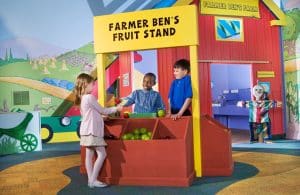Anticipating a new baby is one of the most enjoyable and exciting times in family life. Preparing a child for the birth of a new baby brother or sister, however, requires more than buying a crib and choosing paint colors for the nursery.
According to Betsy Waterman, professor emerita of the counseling and psychological services program at SUNY Oswego, “Having another baby join a family is exciting, but also carries with it a complication that does not exist for the first baby: how and when to share the news with the child or children who are already part of the family. There is no magic time, but most experts would suggest waiting until the pregnancy has passed the first trimester.”
Some children are excited, while others may be angry or scared, but all are sure to have questions, such as “Can I name her?” or “How did the baby get in your tummy?”
Fortunately for parents who are also parents-to-be, there is a wide variety of books to help you prepare for and carry out a discussion on the topic. Books fall roughly into two categories: those that address questions about the biological side of pregnancy and childbirth, and those that bring up changing family roles and how to prepare a child to become a loving and responsible older sibling.
My Mom’s Having a Baby by Dori Hillestad Butler has a conversational tone, giving monthly updates about what is happening as the fetus grows inside the protagonist’s mother. Illustrations accompany text that is scientifically accurate, including detailed descriptions of sex and childbirth. Relatable facts, such as, “He’s only as big as my bottom front tooth,” help to make gestation more concrete. The book concludes with the baby’s birth.
What Makes a Baby by Cory Silverberg provides a description of sperm meeting egg, without the burden of context, making it suitable for any number of situations, including adoption, in-vitro fertilization or surrogacy. This book also mentions both vaginal and cesarean delivery. The uniqueness of this book is that it discusses the roles of sperm, egg, uterus, vagina and childbirth, without ever mentioning either men or women, instead offering explanations such as, “Not all bodies have sperm in them. Some do and some don’t.” Colorful illustrations showcase diversity in both children and caregivers.
It’s Not the Stork by Robie H. Harris is comprehensive, beginning with the differences between boys and girls, progressing through a detailed description of conception and childbirth, and going on to discuss baby’s early days. Diversity in types of families, “good and bad touches,” friendships, relationships and peer pressure make it an appropriate choice for school-age children and tweens.
The New Baby at Your House by Joanna Cole focuses on the social, rather than biological, aspects of welcoming a new baby: acknowledging an older sibling’s range of emotions about having a new baby in the family. With an informative preface for parents, text that parents can read word for word to a child, and photos of many children interacting with the babies in their families, this book is a standout among the many available.
A Baby Sister for Frances by Russell Hoban subtly addresses the jealousy and disruption that children may feel when a new baby joins the family. Frances decides to “run away” to the place under the dining room table because her mother no longer has time to shop for her favorite foods or make sure her favorite clothes are ready to wear to school. Only upon overhearing her parents talk about how much they miss Frances, and about how the baby needs her older sister as a role model, does Frances realize that she is an important part of the family and “comes back home.”
Froggy’s Baby Sister by Jonathan London is a picture book featuring popular fictional character Froggy as he impatiently awaits his tadpole sister, then waits some more for her to become a suitable playmate. Children won’t learn a great deal from this quick, pleasant read but will relate to the frustration of having a baby who’s too young to share adventures with—at first.
How much information and detail to share with a child is a very personal choice, and the books available range from somewhat vague to explicit.
Perhaps the most important thing about which book parents choose is that it’s what librarians call a “good fit book”: If you are comfortable with the content and degree of detail, your child will feel more comfortable with the message.
According to Waterman, one of the simplest ways to begin the process of helping an older sibling or siblings make the transition is one of the easiest. “It is often helpful to have the child help in sharing the exciting news of a new baby with other family members, such as the grandparents.” With an announcement, whether made in person, via Skype or through social media, families may begin the process of telling their own stories.





